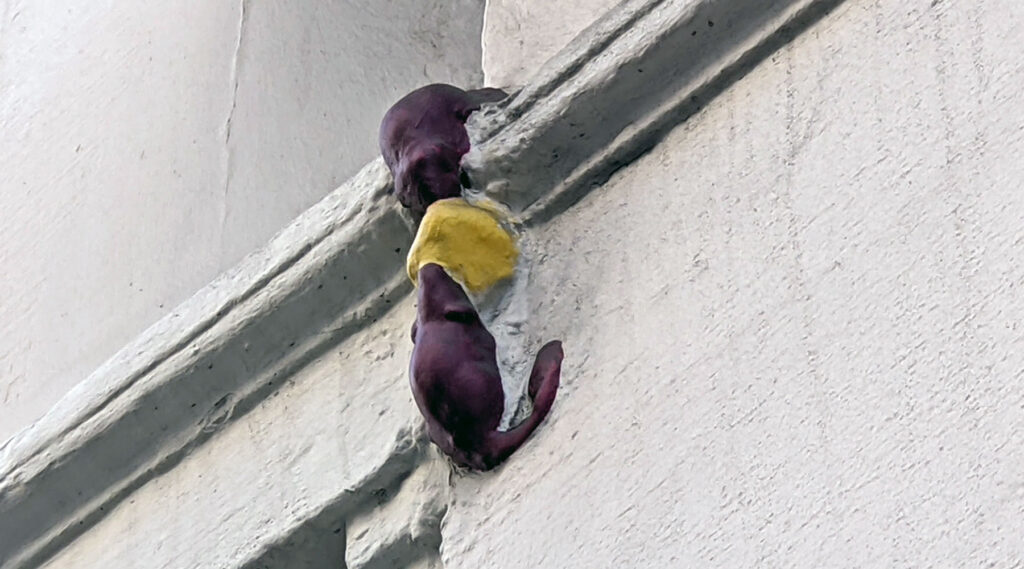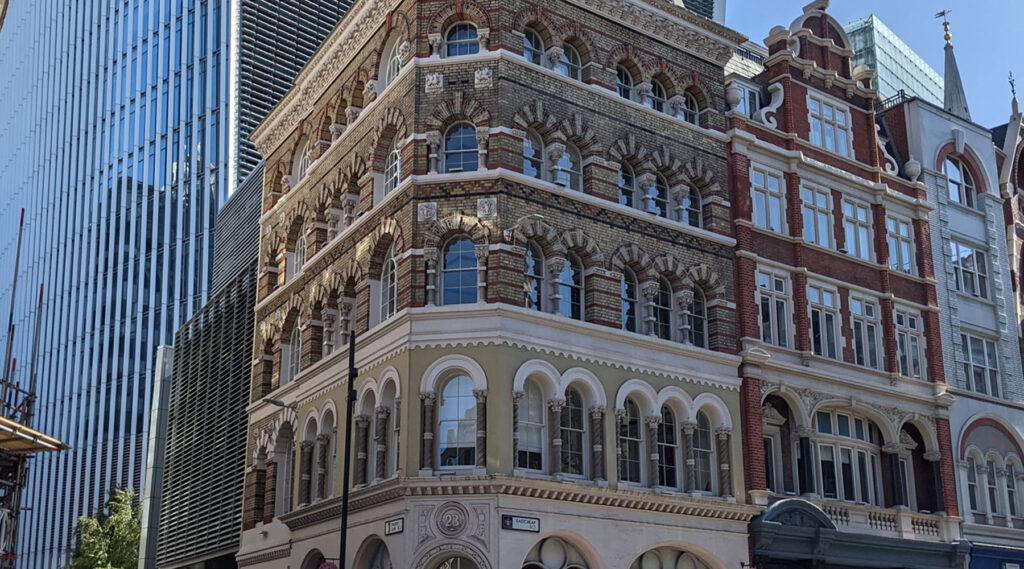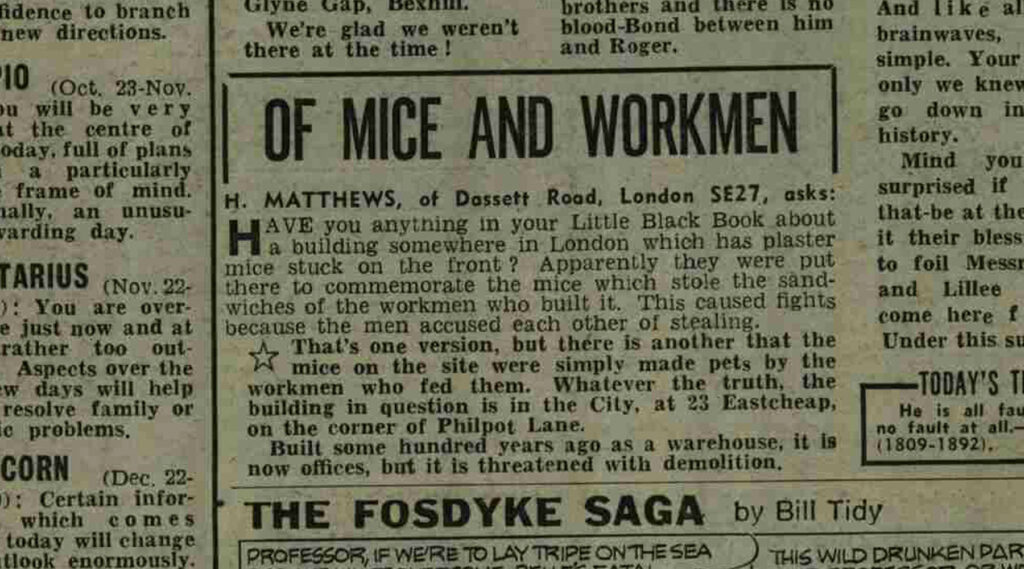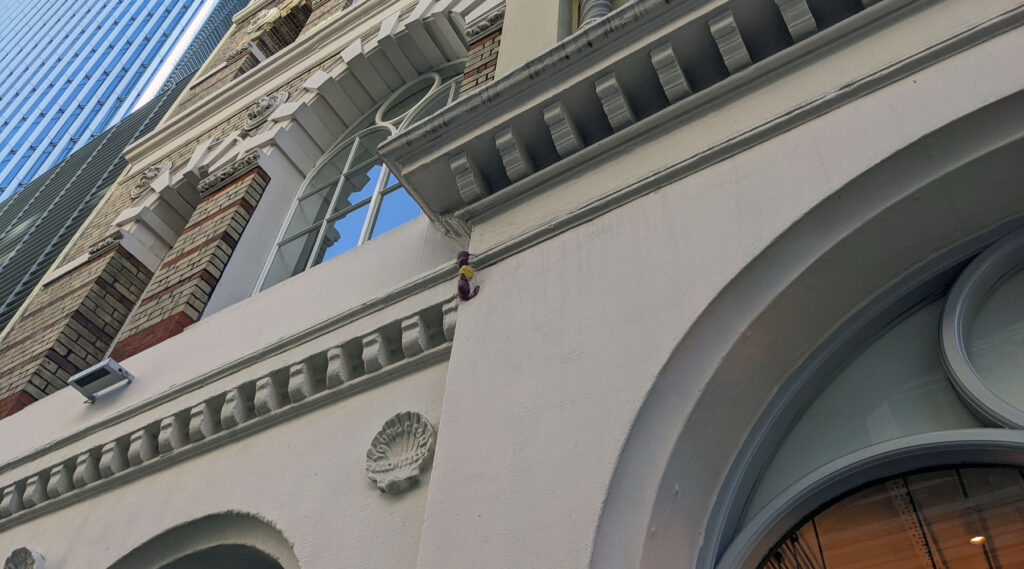A tiny sculpture of two small mice eating a piece of cheese supposedly remembers the death of a building site worker, or does it?
Watch the video
Or read the words
On Philpot Lane, a side street close to Monument tube station in the City of London can be found what is often said to be London’s smallest permanent public sculpture, of two mice eating a piece of cheese.
There’s a story behind this curious sculpture – that most tour guides and taxi drivers passing by will recount.
It varies a bit, but in general, the story is that when the building the mice are on was being built in the 1860s, two men got into a fight after one accused the other of stealing his lunch. In the fight, one of the two fell to his death. They later found two mice eating the lunch having stolen it for themselves. When the building was completed, to remember this fateful accident, the sculpture was added to the side of the building.
Now, there’s a problem with this story, but also something more interesting.
First the debunking.
This was a deadly accident where someone died. Even in Victorian times when deaths on building sites were seen as an unavoidable risk and far more commonplace than today, a death on a building site would probably have been reported in the local newspapers. As the death was the result of a fight, we can expect police reports, almost certainly a court case and a coroner’s report.
None of these seems to exist. It’s possible all the records have been lost, but it seems unlikely that every single record would go missing for just this one case.
There’s also the building itself.
Today this is a classic Victorian building, richly decorated with polychromatic brickwork, but when it was built it was one of the first in this style. So much so that The Builder magazine wrote an architectural review of it. They make no mention of the mice. Now, the Builder was a dry Victorian newspaper and might have ignored the mice if they were just a folly, but it wouldn’t have ignored them if they were a monument to a dead man.
There’s also the nature of the monument — a sculpture of two mice? For a dead man? Monuments would usually be a bronze or stone plaque with the dead man’s name on it. Not a couple of mice.
While I cannot prove the story is wrong, I am comfortable saying it’s highly unlikely to be true.
But, it doesn’t matter if it’s true or not.
What I find fascinating to a degree is how the story came to exist. It’s well known and widely repeated. And has been around for decades. The earliest reference I can find was in 1975 when a reader wrote in to the Daily Mirror asking why the sculpture of the mice was on Philpot Lane.
Generations of Londoners have walked down that short lane with friends, pointed to the two mice up on the wall and told the story.
And it’s the repeating of the story that matters. Just as we tell stories of the Ravens at the Tower of London, of Gog and Magog or the London Stone, knowing they are not true, but they are worth repeating, so the two tiny Philpot Lane mice have joined that pantheon of cultural legends.
They are now as important to our heritage as anything else you might find in London.
And telling the story is important. Over the years, the paint on the mice fades and it would be so easy for a painter one day to slap some whitewash over the mice, and then no one would notice them, find out their story and retell it.
Over the decades, the mice would be forgotten.
But, because people keep pointing at the tiny mice, whenever the building is repainted, as happened recently, the mice get a nice new shiny coat and the cheese is made bright and tasty once more.
And all because people tell the story of the Philpot Lane mice.











I agree that it’s more important that the story be told time and again. Over time it just becomes part of the fascinating folklore of the city.
More videos please, if you will. We knew you know your stuff and the flowing presentation proves it. Thank you Ian.
P.S. Is that radioactive cheese to turn the fur purple?
In recent years the story has escalated to now be about workers on The Monument rather than on the building at Philpot St – eg:
https://www.alamy.com/stock-photo-carving-on-a-city-of-london-building-of-two-mice-fighting-over-piece-99393815.html
And let’s not forget the made-up stuff about the nose on Admiralty Arch, or “Nancy’s Steps”, or the Queen asking permission to enter the City at Temple Bar, or the Trafalgar Sq lanterns coming from the Victory, or Teddington coming from Tide-End Town, or Kingston being from King’s Stone, or Newgate cells in the Viaduct Tavern, or etc, etc, etc…